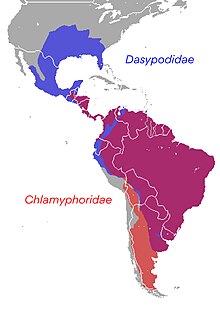有甲目 (學名 :Cingulata )或稱 帶甲目 ,是產自美洲 的一類披甲哺乳动物 ,隸屬有胎盤類 的異關節總目 ,在舊時的分類體系中則被歸為貧齒目 的亞目 。現存種類統稱為犰狳 ,分屬兩科 :犰狳科 與倭犰狳科 [ 1] 更新世 末滅絕的潘帕獸科 ,該科物種體重可達 200 kg[ 2] 大犰狳 (45 kg)[ 3] 末次冰期 的雕齒獸亞科 物種,體重更可達 2000 kg[ 4]
有甲目發源於古新世 的南美洲 ,在 300 萬年前巴拿馬地峽 形成後的南北美洲生物大遷徙 中,其三個科均有部分物種向北擴散[ 5] [ 6] 全新世 古印第安人 殖民美洲不久後滅絕[ 7] [ 8]
有甲目物種的背部有細小的、呈鱗片狀、角質化 的重疊表皮,稱為“鱗甲 皮膚骨化 (osteoderm)形成,並成為其獨有的背甲。大多數物種在肩部及臀部亦有堅實的護盾,並有三到九條以具彈性皮膚分隔開的鱗甲帶覆蓋其側面和底部。[ 9]
潘帕獸的甲殼仍有一定的活動空間,這是由於甲殼之間仍有三條可動的橫向皮膚骨化帶。[ 2] [ 2]
潘帕獸和犰狳均有鱗甲覆蓋於其頭部之上。雕齒獸則擁有被鱗甲厚實包覆的尾部,甚至如星尾獸 在尾巴的末端擁有尾槌,就如同恐龍 中的甲龍亞目 。證據顯示這些尾槌可以用來防禦或是雄性間競爭。[ 4]
許多種犰狳以昆蟲 或其他無脊椎動物為食;部分種類為雜食性 ,以小型脊椎動物與植物為食。潘帕獸則認為是以啃食地面植披為主[ 2] C4 類禾本科 為主食。[ 10] 六帶犰狳亞科 中已滅絕的巨六帶犰狳屬 肉食性動物 。
七帶荷氏獸 (H. septentrionalis )全身骨骼化石,藏於巴塞罗那宇宙盒科技馆 。九帶犰狳 (Dasypus novemcinctus )的骨骼模型,藏於美国国立自然历史博物馆 。雕齒獸 的模式種 (Glyptodon clavipes ),藏於柏林自然博物館 。以下分類反映了有甲目的種系發生 研究結果(Delsuc 等人,2016)。傳統分類認為雕齒獸 是一個獨立於現代犰狳之外的演化支 ,但對星尾獸 的 mtDNA 進行分析發現,星尾獸原本所屬的雕齒獸亞科 與現存的倭犰狳亞科 及三帶犰狳亞科 是同一演化支上的姐妹群 [ 11]
有甲目 (符號“†”表示已滅絕)
?†科 Protobradyidae Ameghino, 1902
†屬 Protobradys Ameghino, 1902 ?†角犰狳科 Peltephilidae Ameghino, 1894
†屬 Anantiosodon Ameghino, 1891
†屬 Epipeltephilus Ameghino, 1904
†屬 Parapeltecoelus Bordas, 1938
†屬 Peltecoelus Ameghino, 1902
†角犰狳屬 Peltephilus Ameghino, 1887 (也被歸於倭犰狳科 ,見下)
†屬 Ronwolffia Shockey, 2017 ?†科 Paleopeltidae Ameghino, 1895
†屬 Palaeopeltis Ameghino, 1895 ?†科 Panochthidae Castellanos, 1927
†屬 Panochthus (Burmeister, 1866) Burmeister 1872
†屬 Hoplophorus Lund, 1838 †潘帕獸科 Pampatheriidae?†屬 Machlydotherium Ameghino, 1902
†荷氏獸屬 Holmesina Simpson, 1930
†屬 Kraglievichia Castellanos, 1927
†屬 Machlydotherium
†潘帕獸屬 Pampatherium Ameghino, 1875 ex Gervais & Ameghino 1880
†屬 Scirrotherium Edmund & Theodor 1997
†屬 Tonnicinctus Góis et al. 2015 [ 12]
†瓦薩里獸屬 Vassallia Castellanos, 1927 (異名 :帕萊獸屬 Plaina Castellanos, 1937 )
†屬 Yuruatherium Ciancio et al. 2012
†科 Pachyarmatheriidae Fernicola et al. 2018
†屬 Neoglyptatelus Carlini, Vizcaíno & Scillato-Yané 1997
†屬 Pachyarmatherium Downing & White 1995
犰狳科 Dasypodidae†屬 Acantharodeia
†屬 Amblytatus
†屬 Archaeutatus
†屬 Astegotherium
†屬 Astegotherium
†屬 Barrancatatus
†屬 Chasicotatus
†屬 Chorobates
†屬 Coelutaetus
†屬 Eocoleophorus
†屬 Epipeltecoelus
†屬 Eutatus
†屬 Hemiutaetus
†屬 Isutaetus
†屬 Lumbreratherium
†屬 Macrochorobates
†屬 Mazzoniphractus
†屬 Meteutatus
†屬 Pedrolypeutes
†屬 Prodasypus
†屬 Proeutatus
†屬 Prostegotherium
†屬 Pucatherium
†屬 Punatherium'
†屬 Stegotherium
†屬 Stenotatus
†屬 Utaetus
†屬 Vetelia
犰狳亞科 Dasypodinae
†屬 Anadasypus
犰狳屬 Dasypus †屬 Nanoastegotherium
†屬 Parastegosimpsonia
†屬 Pliodasypus
†屬 Propraopus
†屬 Riostegotherium
†屬 Stegosimpsonia 倭犰狳科 Chlamyphoridae倭犰狳亞科 Chlamyphorinae
六帶犰狳亞科 Euphractinae
毛犰狳属 Chaetophractus †屬 Doellotatus
六帶犰狳屬 Euphractus †巨六帶犰狳屬 Macroeuphractus
†角犰狳屬 Peltephilus
†屬 Proeuphractus
†屬 Paleuphractus
小犰狳屬 Zaedyus †雕齒獸亞科 Glyptodontinae
†星尾獸屬 Doedicurus
†雕齒獸屬 Glyptodon
†雕獸屬 Glyptotherium
†屬 Hoplophorus
†屬 Panochthus
†屬 Parapropalaehoplophorus
†屬 Plaxhaplous
三帶犰狳亞科 Tolypeutinae
^ Wilson, D.E. & Reeder, D.M. (编). Mammal Species of the World: A Taxonomic and Geographic Reference Baltimore, Maryland : Johns Hopkins University Press . 2005. ISBN 978-0-8018-8221-0LCCN 2005001870 OCLC 62265494 OL 3392515M NLC 001238428 ^ 2.0 2.1 2.2 2.3 Vizcaíno, S. F.; De Iuliis, G.; Bargo , M. S. Skull Shape, Masticatory Apparatus, and Diet of Vassallia and Holmesina (Mammalia: Xenarthra: Pampatheriidae): When Anatomy Constrains Destiny . Journal of Mammalian Evolution. 1998, 5 (4): 291–322 [2011-10-20 ] . doi:10.1023/A:1020500127041 [永久失效連結 ^ Giant Armadillo Priodontes maximus (Kerr, 1792) (页面存档备份 ,存于互联网档案馆 ).) FaunaParaguay.com^ 4.0 4.1 Blanco, R. E.; Jones, W. W.; Rinderknecht, A. The sweet spot of a biological hammer: the centre of percussion of glyptodont (Mammalia: Xenarthra) tail clubs. Proceedings of the Royal Society B: Biological Sciences. 2009-08-26, 276 (1675): 3971–3978. ISSN 0962-8452 doi:10.1098/rspb.2009.1144 ^ Mead, J. I.; Swift, S. L.; White, R. S.; McDonald, H. G.; Baez, A. Late Pleistocene (Rancholabrean) Glyptodont and Pampathere (Xenarthra, Cingulata) from Sonora, Mexico (PDF) . Revista Mexicana de Ciencias Geológicas . 2007, 24 (3): 439–449 (see p. 440) [2013-06-15 ] . (原始内容存档 (PDF) 于2017-08-14). ^ Woodburne, M. O. The Great American Biotic Interchange: Dispersals, Tectonics, Climate, Sea Level and Holding Pens . Journal of Mammalian Evolution. 2010-07-14, 17 (4): 245–264 (see p. 249). ISSN 1064-7554 PMC 2987556 PMID 21125025 doi:10.1007/s10914-010-9144-8 ^ Hubbe, A.; Hubbe, M.; Neves, W. A. The Brazilian megamastofauna of the Pleistocene/Holocene transition and its relationship with the early human settlement of the continent. Earth-Science Reviews. March 2013, 118 : 1–10 (see pages 3, 6). ISSN 0012-8252 doi:10.1016/j.earscirev.2013.01.003 ^ Fiedal, Stuart. Sudden Deaths: The Chronology of Terminal Pleistocene Megafaunal Extinction . Haynes, Gary (编). American Megafaunal Extinctions at the End of the Pleistocene . Springer . 2009: 21–37 (see p. 31) [2015-04-11 ] . ISBN 978-1-4020-8792-9OCLC 313368423 doi:10.1007/978-1-4020-8793-6_2 原始内容 存档于2012-12-05). ^ Dickman, Christopher R. Macdonald, D. , 编. The Encyclopedia of Mammals . New York: Facts on File. 1984: 781 –783. ISBN 0-87196-871-1 ^ Pérez-Crespo, V. A.; Arroyo-Cabrales, J.; Alva-Valdivia, L. M.; Morales-Puente, P.; Cienfuegos-Alvarado, E. Diet and habitat definitions for Mexican glyptodonts from Cedral (San Luis Potosí, México) based on stable isotope analysis. Geological Magazine. 2011-10-18, 149 (01): 153–157. ISSN 0016-7568 doi:10.1017/S0016756811000951 ^ Delsuc, F.; Gibb, G. C.; Kuch, M.; Billet, G.; Hautier, L.; Southon, J.; Rouillard, J.-M.; Fernicola, J. C.; Vizcaíno, S. F.; MacPhee, R. D.E.; Poinar, H. N. The phylogenetic affinities of the extinct glyptodonts. Current Biology. 2016-02-22, 26 (4): R155–R156. doi:10.1016/j.cub.2016.01.039 ^ Flávio Góis; Laureano Raúl González Ruiz; Gustavo Juan Scillato-Yané; Esteban Soibelzon. A Peculiar New Pampatheriidae (Mammalia: Xenarthra: Cingulata) from the Pleistocene of Argentina and Comments on Pampatheriidae Diversity . PLoS ONE. 2015, 10 (6): e0128296. PMC 4470999 PMID 26083486 doi:10.1371/journal.pone.0128296 ^ Guillaume Billet; Lionel Hautier; Christian de Muizon; Xavier Valentin. Oldest cingulate skulls provide congruence between morphological and molecular scenarios of armadillo evolution . Proceedings of the Royal Society. 2011, 278 (1719): 2791–2797. PMC 3145180 PMID 21288952 doi:10.1098/rspb.2010.2443








